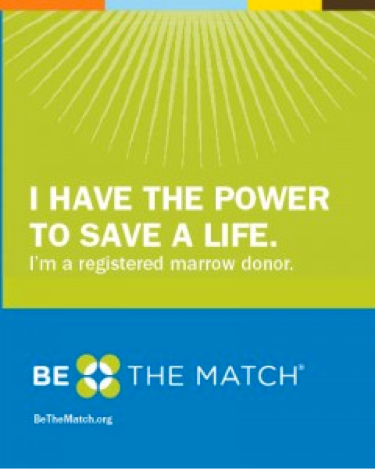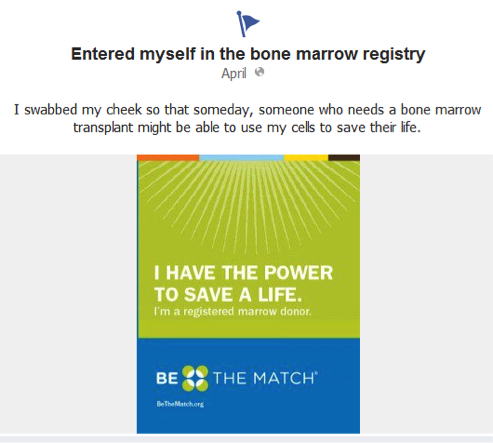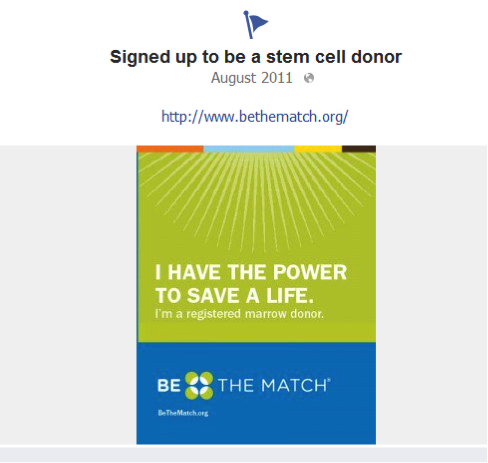 Mark Zuckerberg stopped bathing in money the other week long enough to show the world how you can make your organ donation status a Facebook Timeline Life Event. Wondering how you can market your charity through Facebook timeline? I hadn’t given it much thought until one of my favorite charities tried a similar Facebook Timeline idea out on me, and now it’s seems like such an obvious strategy for every nonprofit.
Mark Zuckerberg stopped bathing in money the other week long enough to show the world how you can make your organ donation status a Facebook Timeline Life Event. Wondering how you can market your charity through Facebook timeline? I hadn’t given it much thought until one of my favorite charities tried a similar Facebook Timeline idea out on me, and now it’s seems like such an obvious strategy for every nonprofit.
Earlier this year I signed up to be a donor to the Bone Marrow Registry at BeTheMatch.org. I’ve been thinking about this for a while, but a series of interactions pushed me over the edge. They were:
- A public appeal for people to sign up to find a match for a child I didn’t know (online/social channel);
- A personal friend who needed a match to cure his long-standing cancer (personal connection);
- A segment on a morning talk show about how easy it is (television!).
(Multi-channel marketing nerds will note that it’s nearly impossible to capture this stream, and yet re-affirms everything we know about multi-channel marketing warming up a prospect and converting them.)
The two step technique was simple to execute, here’s how BeTheMatch did it.
1. They emailed me, pointing out that something small that I did was incredibly important to them and asked me to put it on my Facebook Timeline as a “life event”
Honestly I don’t think about my marrow donation much day to day, just when it comes up in conversation or when I see an ad of some sort. I felt slightly emotional when they emailed me suggesting it was a life event. For someone else, if we match, it surely will be. Once that realization clicked, I was hooked.
2. Provided me a catchy graphic to use in my timeline
BeTheMatch sent this one out along with these instructions. 
If I was designing it I would have made the URL a little bigger, but hey, nobody’s perfect. Also they encouraged me to write my own message. I did, but my friend actually put the URL in there, something they forgot to tell me to do. Look at these two examples and wonder which one is more likely to drive a click to your website.

In this one I wrote a passionate message off-the-cuff, but forgot to include a URL back to the registry where you can sign up to be a donor.

My friend saw my note but had the presence of mind to add a URL to the registry. Anyone that sees this will have a quick click over to a conversion.
3. The Impact
The impact of this was huge, though. When I added it to my timeline, it hit my news stream and ALL my friends saw it. It was a Facebook Life Event, so you can be guaranteed more of them saw it than my recent post about how I shot a really good score at the archery range or about my great camping trip.
A friend who also signed up for the registry saw what I had done and presumably got the same email and did it also.
Secondly, it went into my Timeline of Life Events, alongside the birth of my two children, my marriage, and a half a dozen other related items. That’s some pretty premier neighborhood real estate. If you’re looking at my Life Event Timeline, that’s a lot of great coverage.
How Would You Measure This?
The challenge of this strategy is that it’s difficult to measure, but there are a few techniques that can work well for your organization.
1. Watch for fan acquisition spikes or Facebook interactivity
You should have a daily recording of fan acquisition as well as Facebook activity and have a pretty good idea of what constitutes a data spike. Monitor it while the campaign is running and look for increased mentions.
2. Monitor Facebook generated traffic
Watch your baseline of traffic coming in from Facebook. You’ll need a long baseline to rule out seasonal variations. This would only record people who happened to follow a link from Facebook though. If someone saw it and thought, “Hey, that looks cool!” and fired up another browser window and typed in your URL, you wouldn’t see a referral from Facebook, you’d see “direct” traffic.
3. Watch for a spike in email signups and donation completion rate
You should already have a pretty good sense of what percentage of your traffic signs up for your email list, in the form of “For every 1,000 visitors we get, 25 of them sign up for email”. If this subscription rate spikes, or the completion rate on your forms go up, that’s a sign you’ve got motivated prospects coming in. If you’re running no other promotion, then this probably due to this sort of campaign.
Of course, you can also ask your donors what marketing touches affected their decision.
Best Practices
There’s a couple of best practices you can take away from this example:
- Provide your users an eye-catching graphic, or better yet, a few to choose from. The 300x240 size is pretty good. Include a sizable URL in the graphic. If you are in Animal Welfare and pets, consider letting your users add their own photo to a template you provide to personalize it.
- Encourage your users to write a personal note for the timeline and don’t let them forget to include a URL to your page or to tag you in the posting.
- Identify your baseline Facebook activity and website clicks from Facebook. Look for a lift due to your Timeline campaign.
*Shabbir Imber Safdar is the Chief Data Nerd at The Safdar Analytics Group, a San Francisco-based boutique agency that specializes in digital measurement and innovative online cause campaigns. He’s a certified digital analyst by the Digital Analytics Association. Occasionally he gets paid to make earthquake videos and destroy fishtanks and wineracks


COMMENTS